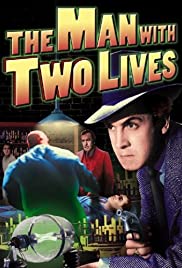
THE MAN WITH TWO LIVES
US, 1942, 64 minutes, Black-and-white.
Edward Norris, Marlo Dwyer, Eleanor Lawson, Frederick Burton, Addison Richards, Edward Keane, Hugh Sothern, Tom Seidl, Anthony Warde.
Directed by Phil Rosen.
This is a B-budget supporting feature. It capitalises on audience interest in medical experimentation, this time in the possibility of resuscitating the heart of a dead man. There are discussions between a medical doctor and the emphasis on signs and rigorous evidence and a psychologist who talks about the soul. There are discussions about the morality of this kind of experimentation.
In this way, the plot draws on the Frankenstein story, the experimenting, wanting to make new life, and creating some kind of monster.
After everybody is gathered for the celebration of an engagement, the fiance, Philip, played by Edward Norris, is involved in a car crash. The decision is made, especially with the urging of the dead man’s father, to try an experiment. In the meantime, there has also been some discussion about the transmigration of souls, as well as, at about a vicious criminal to be executed at midnight.
Needless to say, the resuscitation takes place at midnight with the result that the criminal’s soul inhabits the dead man. Rather quickly, the criminal assumes the leadership of the gang and its robberies, flirting with the dead man’s girlfriend. Since the running time is very short, the leadership of the gang is quickly established, the double life of Philip, his fiancee and friends very much concerned. There are some murders, especially as members of the gang and his girlfriend become aware of his respectable identity.
An informer gives the police information about a robbery. There is a raid, Phillip returning to his respectable home, the detective arriving, the confrontation, Phillip being shot – but, this is 1942, and there is a happy ending as he revives and his true soul trains migrates back home.
The director is Phil Rosen, who worked with Edison in filming The Miracle Man in 1912, began direction in 1915, prolific in small-budget features, his career cut short by his death in 1951.